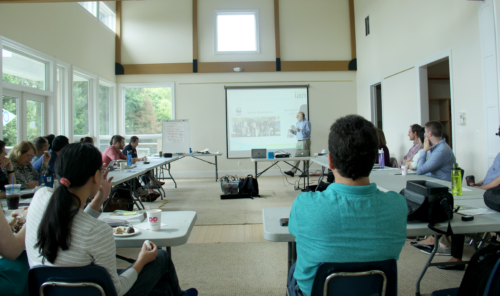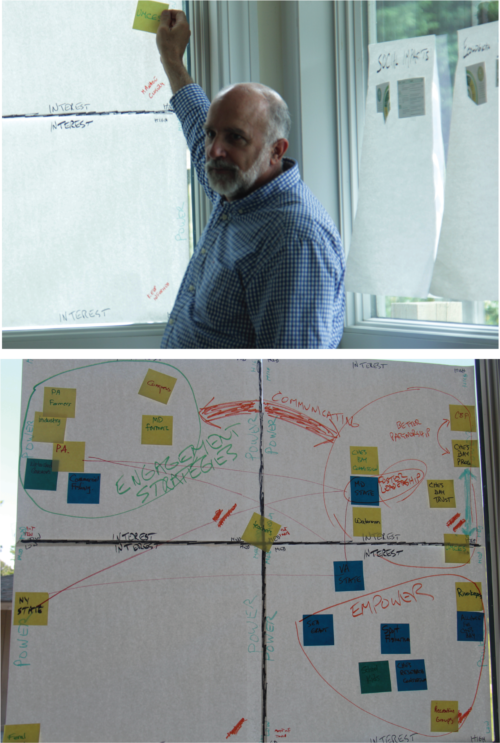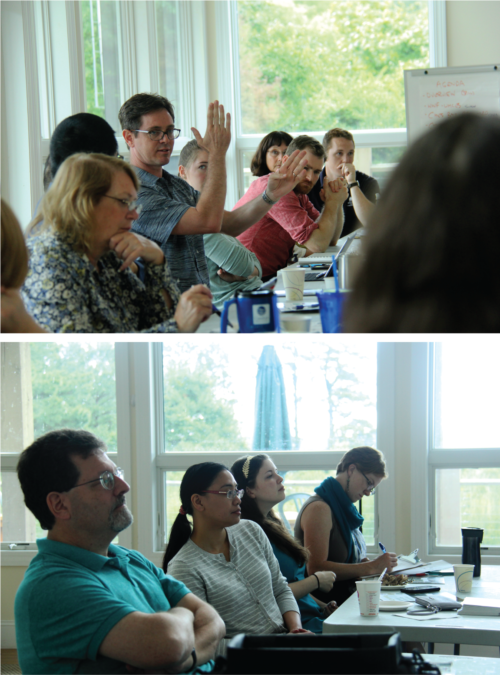Annual IAN Retreat at Chesapeake Bay Environmental Center
Bill Dennison ·The Integration and Application Network annual retreat was held at the Chesapeake Bay Environmental Center on Kent Narrows on May 31. Two dozen IAN staff spent the day introducing themselves to each other, discussing the IAN report card and the IAN brand. This annual gathering includes our University of Maryland Center for Environmental Science and Chesapeake Bay Program staff (UMCES@CBP). The exercise we used to introduce ourselves to one another was to provide 3-5 photos from last year's personal and professional activities and identify a favorite song and artist. Dylan Taillie assembled the photos into a PowerPoint with the downloaded music playing in the background. This way, everyone had the opportunity to share their images and explain their meaning, including an explanation of the musical choice. It was fun to hear different music and see all the interesting places people had traveled. There was a combination of travel to nature and to big cities. Lots of animals were featured, both wild and domesticated. Many significant life events had occurred, including graduations, weddings, babies, and moves. I enjoyed the diverse music, and am still incredulous that Richard Tian's musical choice was Madonna's Material Girl. We have many new IAN staff this year, so this exercise was a good way to provide introductions.

One of the major goals of this year's retreat was to reflect on the first IAN report card, released a few months ago. In addition to the publicly released IAN report card, we produced an introspective report card which was also discussed. We broke the discussion into two major questions: How do we improve our report card scores? And what can we do to make the report card better? For the publicly released report card, the three major categories are the following: Partnership Satisfaction, Social Impacts, and Ecological Outcomes. For the introspective report card, the four categories are the following: Financial Viability, Capacity Building, Functionality, and Staff Happiness. There were a lot of creative suggestions for improving report card scores in each category. We will be working in the coming months both to improve the report card scores and to improve the manner in which we assess our progress toward achieving our goals.

We conducted a stakeholder mapping exercise during our breaks. Vanessa Vargas helped run this exercise. We created a plot of low to high interest vs. low to high power regarding Chesapeake Bay restoration. We placed a diversity of organizations and sectors onto this interest vs. power plot using sticky notes. We ended up with three groupings. One grouping was in the low interest but powerful category, including congress, industry and agriculture, and commercial fishing. Another grouping was the high interest, but not very powerful category, including riverkeepers, school children, and recreation groups. The other grouping was the high interest, powerful category, including the Chesapeake Bay Program, Chesapeake Bay Foundation, and Chesapeake Research Consortium. For the Chesapeake Bay signatory states (Maryland, Virginia, Pennsylvania, New York, West Virginia, and Delaware), there were diversity of placements. For example, Maryland had the highest interest and power to influence Chesapeake Bay restoration, but Pennsylvania had little interest, in spite of their power to influence Chesapeake Bay restoration. For each of these groupings, we made recommendations of what IAN could do to enhance the Chesapeake Bay restoration process. For the low interest but powerful group, we could develop engagement strategies to increase their interest in Chesapeake Bay restoration. For the high interest and powerful position grouping, we could foster better partnerships and help them communicate to the low interest groups. For the interested but not very powerful groups, IAN could help empower them. An example of this approach is the regional report cards that we help riverkeeper groups produce.

Another session that we conducted was a discussion of IAN taglines. In order to develop a tag line that conveys the confidence that groups should feel in making a difference with IAN, we began by identifying key stakeholders, their goals and their feelings. We emulated the format and approach that we used in our WWF-UMCES partnership to develop the 'Healthy Rivers for All' tag line. We established that the major audiences for IAN products included the interested public, state and federal policy makers/resource managers, and environmental scientists. These groups often feel insecure, uncertain, and overwhelmed by the daunting environmental issues that confront them. The state and federal policymakers/resource managers care about being adequately informed and about their level of understanding and the public perception of their knowledge. The scientists care about their peer credibility, uncertain funding and about developing a deep understanding of their specialty. The interested public care about their safety and security, obtaining reliable information, and future environmental status. Our next step is to identify potential tag lines and branding messages that will address the feelings and perceptions of our key target demographics.

We also handed out two sided cards for everyone to fill out. Emily Nastase had produced the cards for the International Landscape Ecology Conference where I delivered an after dinner talk. On one side of the cards, Randy Olson's ABT (. . . and . . . but . . . therefore . . . ) format solicited feedback in a structured narrative. There were some really good narratives, and my favorites included the following:
- "There is a global need for strong science communication skills, AND behavior change advocacy, BUT we live in a world of misinformation, THEREFORE the training and education provided by IAN is critical for supporting social and ecological change in the world."
- "IAN is a respected science communication group that has grown over the years, AND has recently expanded to thinking about engagement and global coupled systems, BUT we do not adequately understand what works and what can change, THEREFORE it is necessary to do self-assessments of our impact and research best practices and new techniques in order to continually improve and effectively engage new partners."
The other side of the card solicited one word to describe IAN, using the format "Nothing makes sense in IAN, except in light of _________ . Answers included communication, science translation, stakeholders, and sound science. My answer was the talented and exceptional staff.
We enjoyed some good food and discussions during the breaks, while watching the wildlife outside. Jamie Currie organized our group photos, and we used every opportunity to escape outside during the day. As always, I came away from these infrequent, but important gatherings, appreciating the incredibly talented and capable people that comprise the IAN enterprise. I also reaffirmed how much fun these people are to spend time with. I look forward to the follow up activities from the retreat that will continue to connect our group with one another.

.
About the author
Bill Dennison

Dr. Bill Dennison is a Professor of Marine Science and Vice President for Science Application at the University of Maryland Center for Environmental Science.